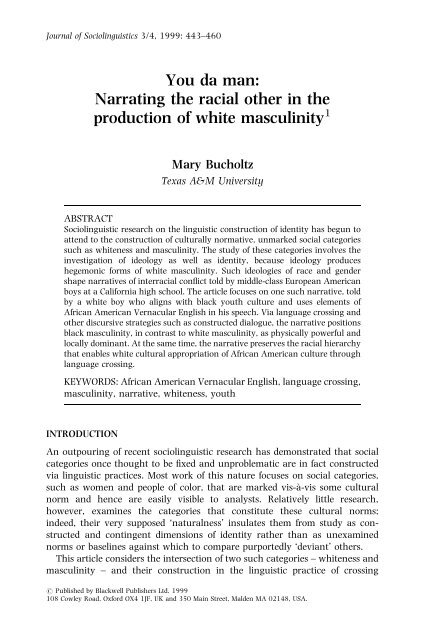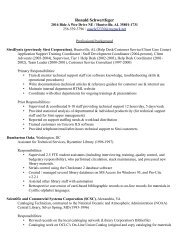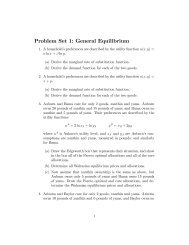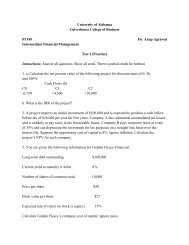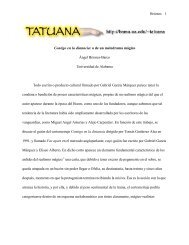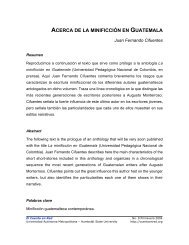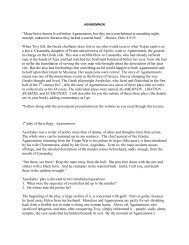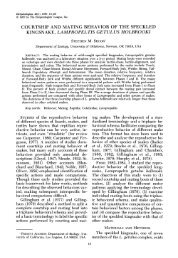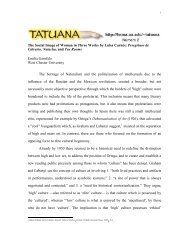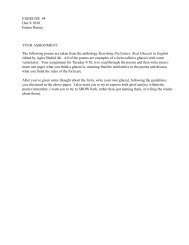You da man: Narrating the racial other in the ... - Bama.Ua.Edu
You da man: Narrating the racial other in the ... - Bama.Ua.Edu
You da man: Narrating the racial other in the ... - Bama.Ua.Edu
You also want an ePaper? Increase the reach of your titles
YUMPU automatically turns print PDFs into web optimized ePapers that Google loves.
Journal of Sociol<strong>in</strong>guistics 3/4, 1999: 443±460<br />
<strong>You</strong> <strong>da</strong> <strong>man</strong>:<br />
<strong>Narrat<strong>in</strong>g</strong> <strong>the</strong> <strong>racial</strong> o<strong>the</strong>r <strong>in</strong> <strong>the</strong><br />
production of white mascul<strong>in</strong>ity 1<br />
Mary Bucholtz<br />
Texas A&M University<br />
ABSTRACT<br />
Sociol<strong>in</strong>guistic research on <strong>the</strong> l<strong>in</strong>guistic construction of identity has begun to<br />
attend to <strong>the</strong> construction of culturally normative, unmarked social categories<br />
such as whiteness and mascul<strong>in</strong>ity. The study of <strong>the</strong>se categories <strong>in</strong>volves <strong>the</strong><br />
<strong>in</strong>vestigation of ideology as well as identity, because ideology produces<br />
hegemonic forms of white mascul<strong>in</strong>ity. Such ideologies of race and gender<br />
shape narratives of <strong>in</strong>ter<strong>racial</strong> con¯ict told by middle-class European American<br />
boys at a California high school. The article focuses on one such narrative, told<br />
by a white boy who aligns with black youth culture and uses elements of<br />
African American Vernacular English <strong>in</strong> his speech. Via language cross<strong>in</strong>g and<br />
o<strong>the</strong>r discursive strategies such as constructed dialogue, <strong>the</strong> narrative positions<br />
black mascul<strong>in</strong>ity, <strong>in</strong> contrast to white mascul<strong>in</strong>ity, as physically powerful and<br />
locally dom<strong>in</strong>ant. At <strong>the</strong> same time, <strong>the</strong> narrative preserves <strong>the</strong> <strong>racial</strong> hierarchy<br />
that enables white cultural appropriation of African American culture through<br />
language cross<strong>in</strong>g.<br />
KEYWORDS: African American Vernacular English, language cross<strong>in</strong>g,<br />
mascul<strong>in</strong>ity, narrative, whiteness, youth<br />
INTRODUCTION<br />
An outpour<strong>in</strong>g of recent sociol<strong>in</strong>guistic research has demonstrated that social<br />
categories once thought to be ®xed and unproblematic are <strong>in</strong> fact constructed<br />
via l<strong>in</strong>guistic practices. Most work of this nature focuses on social categories,<br />
such as women and people of color, that are marked vis-aÁ-vis some cultural<br />
norm and hence are easily visible to analysts. Relatively little research,<br />
however, exam<strong>in</strong>es <strong>the</strong> categories that constitute <strong>the</strong>se cultural norms;<br />
<strong>in</strong>deed, <strong>the</strong>ir very supposed `naturalness' <strong>in</strong>sulates <strong>the</strong>m from study as constructed<br />
and cont<strong>in</strong>gent dimensions of identity ra<strong>the</strong>r than as unexam<strong>in</strong>ed<br />
norms or basel<strong>in</strong>es aga<strong>in</strong>st which to compare purportedly `deviant' o<strong>the</strong>rs.<br />
This article considers <strong>the</strong> <strong>in</strong>tersection of two such categories ± whiteness and<br />
mascul<strong>in</strong>ity ± and <strong>the</strong>ir construction <strong>in</strong> <strong>the</strong> l<strong>in</strong>guistic practice of cross<strong>in</strong>g<br />
# Published by Blackwell Publishers Ltd. 1999<br />
108 Cowley Road, Oxford OX4 1JF, UK and 350 Ma<strong>in</strong> Street, Malden MA 02148, USA.
444<br />
BUCHOLTZ<br />
(Rampton 1995). Through a detailed analysis of a narrative about <strong>in</strong>ter<strong>racial</strong><br />
con¯ict told by a middle-class European American boy who a liates with<br />
African American youth culture, I argue that cross<strong>in</strong>g <strong>in</strong>to African American<br />
Vernacular English (AAVE), <strong>in</strong> conjunction with o<strong>the</strong>r discursive strategies, is a<br />
semiotic resource for <strong>the</strong> construction of identity at several levels. On <strong>the</strong> one<br />
hand, as a speech practice that <strong>the</strong> speaker engages <strong>in</strong> across contexts, it<br />
produces and projects <strong>the</strong> speaker's urban youth identity (see also Cutler this<br />
issue). On <strong>the</strong> o<strong>the</strong>r hand, <strong>in</strong> <strong>the</strong> context of a narrative of <strong>in</strong>ter<strong>racial</strong> con¯ict,<br />
<strong>the</strong>se discursive resources are reworked to highlight <strong>racial</strong> and gendered<br />
dimensions of <strong>the</strong> self as well as <strong>the</strong> `o<strong>the</strong>r': African American youth. 2<br />
THE SOCIOLINGUISTIC INVESTIGATION OF WHITE MASCULINITY<br />
Traditionally, sociol<strong>in</strong>guistic research has not focused on whiteness or mascul<strong>in</strong>ity<br />
as ideologically privileged categories. More recently, however, several studies<br />
have taken this issue as <strong>the</strong>ir start<strong>in</strong>g po<strong>in</strong>t and have made it clear that such<br />
normative categories are constructed <strong>in</strong> relation to di€erence (Bell this issue;<br />
Cameron 1997; Hill 1998). But despite ideologies of normativity, nei<strong>the</strong>r whiteness<br />
nor mascul<strong>in</strong>ity is monolithic. Their local forms creatively respond to<br />
dom<strong>in</strong>ant ideologies ra<strong>the</strong>r than mechanically re¯ect<strong>in</strong>g <strong>the</strong>m. In <strong>the</strong> process,<br />
new ideological structures may emerge. Whiteness and mascul<strong>in</strong>ity are <strong>the</strong>refore<br />
terms that encapsulate both identity and ideology. For example, while most males<br />
can be said to project some form of mascul<strong>in</strong>ity <strong>in</strong> at least some contexts (that is, as<br />
identity), only a certa<strong>in</strong> subset of possible or actual mascul<strong>in</strong>ities are culturally<br />
acceptable (that is, as ideology). And even culturally and <strong>in</strong>stitutionally dom<strong>in</strong>ant<br />
forms of mascul<strong>in</strong>ity may shift from moment to moment (cf. Kiesl<strong>in</strong>g 1998); as<br />
Robert Connell writes <strong>in</strong> his study of Western mascul<strong>in</strong>ity, ` ``Hegemonic<br />
mascul<strong>in</strong>ity'' is not a ®xed character type, always and everywhere <strong>the</strong> same. It<br />
is, ra<strong>the</strong>r, <strong>the</strong> mascul<strong>in</strong>ity that occupies <strong>the</strong> hegemonic position <strong>in</strong> a given pattern<br />
of gender relations, a position always contestable' (1995: 76). Connell argues that<br />
<strong>in</strong> its current form hegemonic mascul<strong>in</strong>ity ± <strong>the</strong> gender ideology and practice<br />
associated with <strong>in</strong>stitutional power ± conta<strong>in</strong>s tensions between dom<strong>in</strong>ance and<br />
violence on <strong>the</strong> one hand and rationality and technical expertise on <strong>the</strong> o<strong>the</strong>r,<br />
with rational power replac<strong>in</strong>g physical power as <strong>the</strong> source of dom<strong>in</strong>ation.<br />
Physically based mascul<strong>in</strong>ities are thus becom<strong>in</strong>g subord<strong>in</strong>ated, <strong>in</strong> Connell's<br />
terms (see also McElh<strong>in</strong>ny 1995). One type of subord<strong>in</strong>ated mascul<strong>in</strong>ity, Connell<br />
notes, is black mascul<strong>in</strong>ity. In practice, black men's mascul<strong>in</strong>ities are multiple,<br />
but at <strong>the</strong> ideological level this diversity of gender identities is reduced to<br />
monolithic forms of mascul<strong>in</strong>ity that stand counter to <strong>the</strong> hegemonic white norm.<br />
As a consequence of racism, black mascul<strong>in</strong>ity <strong>in</strong> <strong>the</strong> United States (and<br />
elsewhere) has long been ideologically associated with a hyperphysicality that<br />
<strong>in</strong>volves physical strength, hyper(hetero)sexuality, and physical violence (Davis<br />
1983), and blackness has often been ideologically l<strong>in</strong>ked more to men than to<br />
women, as Marcyliena Morgan (1999) notes. Because of this complex of<br />
# Blackwell Publishers Ltd. 1999
NARRATIVE AND WHITE MASCULINITY 445<br />
cultural ideologies, <strong>the</strong> use of AAVE can, <strong>in</strong> certa<strong>in</strong> marked contexts, <strong>in</strong>dexically<br />
l<strong>in</strong>k blackness and a hyperphysical mascul<strong>in</strong>ity. And because white mascul<strong>in</strong>ity<br />
can exist only <strong>in</strong> relation to o<strong>the</strong>r forms of mascul<strong>in</strong>ity (and to fem<strong>in</strong><strong>in</strong>ity), by<br />
cross<strong>in</strong>g <strong>in</strong>to AAVE middle-class European American males may paradoxically<br />
be construct<strong>in</strong>g <strong>the</strong>mselves as (certa<strong>in</strong> k<strong>in</strong>ds of ) white men.<br />
THE BAY CITY HIGH SCHOOL STUDY<br />
This article o€ers one example of how AAVE may be used toge<strong>the</strong>r with o<strong>the</strong>r<br />
l<strong>in</strong>guistic resources <strong>in</strong> <strong>the</strong> production of white mascul<strong>in</strong>ity. The <strong>da</strong>ta are taken<br />
from a set of narratives of <strong>racial</strong>ized con¯ict told by European American boys at<br />
a multi<strong>racial</strong> urban high school <strong>in</strong> California that I call Bay City High. I describe<br />
<strong>the</strong>se con¯icts as <strong>racial</strong>ized ra<strong>the</strong>r than <strong>racial</strong> to emphasize that <strong>the</strong>ir <strong>racial</strong><br />
mean<strong>in</strong>g is not natural or <strong>in</strong>evitable (although <strong>the</strong> narratives imply that it is)<br />
but ra<strong>the</strong>r is constructed through discourse. Race is made relevant ± <strong>in</strong>deed,<br />
race is made, along with gender ± <strong>in</strong> <strong>the</strong> narrative choices of <strong>the</strong> storytellers.<br />
The <strong>da</strong>ta were collected dur<strong>in</strong>g ethnographic ®eldwork at Bay City High <strong>in</strong><br />
1995±96. Despite its diversity, <strong>the</strong> school is <strong>racial</strong>ly organized along an<br />
ideologically de®ned black-white dichotomy that structures students' social<br />
worlds. Yet <strong>man</strong>y European American students symbolically cross this divide<br />
through l<strong>in</strong>guistic and o<strong>the</strong>r social practices that <strong>in</strong>dex <strong>the</strong>ir a liation with<br />
African American youth culture, and especially hip hop. By draw<strong>in</strong>g on a<br />
l<strong>in</strong>guistic variety widely and almost exclusively associated with African Americans,<br />
<strong>the</strong> narrator of <strong>the</strong> story under analysis here, like numerous o<strong>the</strong>r white<br />
teenagers at Bay City High, uses elements of AAVE <strong>in</strong> his ord<strong>in</strong>ary speech style as<br />
part of his projection of an urban youth identity <strong>in</strong>¯uenced by African American<br />
youth culture (cf. Hewitt 1986 for an analogous situation among white youth <strong>in</strong><br />
England). AAVE, as a symbolic marker of African American youth culture,<br />
becomes a commodity that urban-identi®ed European American youth can<br />
easily appropriate, at least partially and imperfectly. I term such use Cross-<br />
Racial AAVE, or CRAAVE, where <strong>the</strong> acronym is <strong>in</strong>tended to re¯ect speakers'<br />
sometimes ambivalent cultural and l<strong>in</strong>guistic desire ± a desire often encapsulated<br />
<strong>in</strong> o<strong>the</strong>r white students' scornful if <strong>in</strong>accurate assessment, `He (or she) wants to<br />
be black.' (Girls as well as boys use elements of AAVE, with consequences for both<br />
<strong>racial</strong> and gender identity and ideology; however, girls' language use is not<br />
analyzed <strong>in</strong> this article.) Although CRAAVE risks imply<strong>in</strong>g that cross-<strong>racial</strong> use of<br />
AAVE features has a s<strong>in</strong>gle social mean<strong>in</strong>g (much as <strong>the</strong> term AAVE itself implies<br />
a unitary speech community of users: Morgan 1999), it is useful for dist<strong>in</strong>guish<strong>in</strong>g<br />
between unmarked AAVE use by African Americans and marked AAVE use<br />
by European Americans at Bay City High. The term is shorthand for an <strong>in</strong>dexical<br />
relationship between certa<strong>in</strong> embodied and contextualized uses of AAVE and a<br />
particular European American urban youth identity.<br />
CRAAVE is not a uni®ed speech style; di€erent speakers draw on di€erent<br />
features of AAVE phonology, syntax, and morphology, and <strong>the</strong>ir speech does<br />
# Blackwell Publishers Ltd. 1999
446<br />
BUCHOLTZ<br />
not correspond to most African Americans' l<strong>in</strong>guistic patterns. Yet CRAAVE is<br />
understood as an emblematic use of AAVE both by African Americans and by<br />
o<strong>the</strong>r European Americans. Not all European American uses of AAVE features<br />
count as CRAAVE: <strong>the</strong> social mean<strong>in</strong>g of a particular feature <strong>in</strong> use depends on<br />
<strong>the</strong> details of context. For example, two case studies (Hatala 1976; Sweetland<br />
1998) describe cross-<strong>racial</strong> AAVE use without commodi®cation or appropriation,<br />
<strong>the</strong> di€erence be<strong>in</strong>g that <strong>the</strong> white speakers <strong>in</strong> those studies were fully<br />
<strong>in</strong>tegrated <strong>in</strong>to <strong>the</strong> African American speech community. Such uses would not<br />
be classi®ed as CRAAVE.<br />
In <strong>the</strong> <strong>da</strong>ta analyzed below, <strong>the</strong> narrator, Brand One (a pseudonym), a middleclass<br />
European American boy, uses language cross<strong>in</strong>g toge<strong>the</strong>r with o<strong>the</strong>r<br />
narrative strategies to l<strong>in</strong>k race and gender both discursively and ideologically.<br />
He <strong>in</strong>vokes race and gender identity explicitly, through <strong>the</strong> content of <strong>the</strong><br />
narrative, and implicitly, through his l<strong>in</strong>guistic choices <strong>in</strong> narration.<br />
The occasion of <strong>the</strong> story was a discussion with me about current slang; <strong>the</strong><br />
story was triggered by <strong>the</strong> mention of <strong>the</strong> threat watch your back. When asked if<br />
he uses this expression, Brand One narrated a recent confrontation between<br />
himself and an unnamed African American male antagonist who, accord<strong>in</strong>g to<br />
<strong>the</strong> narrative, attempts to steal from Brand One's backpack and <strong>the</strong>n threatens<br />
physical violence. In <strong>the</strong> narrative, Brand One ultimately escapes both physical<br />
harm and humiliation when two African American male `gangsters' of his<br />
acqua<strong>in</strong>tance arrive and come to his defense. That <strong>the</strong> narrative is shaped for its<br />
audience (a white female adult researcher) is shown <strong>in</strong> <strong>the</strong> glosses that Brand<br />
One provides for slang terms he uses dur<strong>in</strong>g <strong>the</strong> narrative, such as mugg<strong>in</strong>g (l<strong>in</strong>e<br />
71) and break (l<strong>in</strong>e 77), as well as <strong>in</strong> his will<strong>in</strong>gness to raise <strong>the</strong> topic of race,<br />
which white students at Bay City High are usually reluctant to do outside of<br />
predom<strong>in</strong>antly white sett<strong>in</strong>gs. Also evident is <strong>the</strong> narrative's connection to<br />
mascul<strong>in</strong>ity: no European American girls <strong>in</strong> my study told me similar stories<br />
(although <strong>the</strong>y may have told such stories <strong>in</strong> o<strong>the</strong>r contexts), and girls never<br />
featured <strong>in</strong> <strong>the</strong> stories told by boys. This is not to say that ®ght narratives are an<br />
<strong>in</strong>herently mascul<strong>in</strong>e genre: female speakers are equally able to represent<br />
<strong>the</strong>mselves narratively <strong>in</strong> situations of con¯ict and violence (Shu<strong>man</strong> 1986).<br />
In <strong>the</strong> context of <strong>the</strong> study, however, ®ght stories served as resources for <strong>the</strong><br />
construction of mascul<strong>in</strong>ity as well as <strong>racial</strong> identity <strong>in</strong> a public, for-<strong>the</strong>-record<br />
tell<strong>in</strong>g of personal experience to an outside researcher (cf. O'Connor 1997).<br />
CROSSING AND CONSTRUCTED DIALOGUE IN NARRATIVE<br />
Because narratives are performed and <strong>the</strong>refore highly self-conscious speech<br />
events, narratives may have no direct relation to speakers' experience. The<br />
analysis thus di€erentiates between <strong>the</strong> narrator and <strong>the</strong> protagonist, although<br />
<strong>the</strong>y are <strong>the</strong> same biographical person (Brand One), and <strong>the</strong> term ®gure<br />
(Go€<strong>man</strong> 1974: 523) is used to refer to <strong>the</strong> characters <strong>in</strong> <strong>the</strong> narrative, <strong>in</strong><br />
order to emphasize that <strong>the</strong>y are narrative constructs ra<strong>the</strong>r than `real' entities.<br />
# Blackwell Publishers Ltd. 1999
NARRATIVE AND WHITE MASCULINITY 447<br />
Crucial to <strong>the</strong> narrative's e€ect is <strong>the</strong> use of constructed dialogue (Tannen<br />
1989). A useful perspective on constructed dialogue <strong>in</strong> Brand One's narrative is<br />
provided by Erv<strong>in</strong>g Go€<strong>man</strong>'s analytic separation of `speaker' <strong>in</strong>to animator,<br />
pr<strong>in</strong>cipal, and author: his analysis highlights <strong>the</strong> fact that di€erent <strong>in</strong>teractional<br />
identities may be at work <strong>in</strong> a s<strong>in</strong>gle quoted utterance. Fur<strong>the</strong>r, di€erent<br />
strategies of animation may be employed simultaneously, so that a s<strong>in</strong>gle<br />
utterance may be at once a quotation, a `say-for,' and a `mockery' (to use<br />
Go€<strong>man</strong>'s 1974: 534 term<strong>in</strong>ology). Because quotation is <strong>the</strong> speech of both self<br />
and o<strong>the</strong>r, it shares with <strong>the</strong>se o<strong>the</strong>r forms of animation `<strong>the</strong> process of project<strong>in</strong>g<br />
an image of someone not oneself while prevent<strong>in</strong>g viewers from forgett<strong>in</strong>g even<br />
for a moment that an alien animator is at work' (Go€<strong>man</strong> 1974: 534).<br />
Like Go€<strong>man</strong>'s frame analysis, Mikhail Bakht<strong>in</strong>'s de®nition of double-voiced<br />
discourse recognizes that multiple layers of identity of self and o<strong>the</strong>r may be<br />
present <strong>in</strong> a s<strong>in</strong>gle discourse:<br />
It [double-voiced discourse] serves two speakers at <strong>the</strong> same time and expresses<br />
simultaneously two di€erent <strong>in</strong>tentions: <strong>the</strong> direct <strong>in</strong>tention of <strong>the</strong> character who is<br />
speak<strong>in</strong>g, and <strong>the</strong> refracted <strong>in</strong>tention of <strong>the</strong> author. In such discourse <strong>the</strong>re are two<br />
voices, two mean<strong>in</strong>gs and two expressions. And all <strong>the</strong> while <strong>the</strong>se two voices are<br />
dialogically <strong>in</strong>terrelated, <strong>the</strong>y ± as it were ± know about each o<strong>the</strong>r (just as two<br />
exchanges <strong>in</strong> a dialogue know of each o<strong>the</strong>r and are structured <strong>in</strong> this mutual<br />
knowledge of each o<strong>the</strong>r); it is as if <strong>the</strong>y actually hold a conversation with each o<strong>the</strong>r.<br />
. . . A potential dialogue is embedded <strong>in</strong> <strong>the</strong>m, one as yet unfolded, a concentrated<br />
dialogue of two voices, two world views, two languages. (Bakht<strong>in</strong> 1981: 324±325)<br />
In Brand One's narrative, cross<strong>in</strong>g is used <strong>in</strong> constructed dialogue and elsewhere<br />
to create this double-voiced e€ect through <strong>the</strong> animation of multiple<br />
voices. Ideologies of race and gender are <strong>in</strong>voked via such discursive strategies<br />
to construct a black mascul<strong>in</strong>ity <strong>in</strong> opposition to Brand One's own version of<br />
white mascul<strong>in</strong>ity.<br />
RACE AND GENDER LEXICALIZED<br />
It is not always apparent when speakers are construct<strong>in</strong>g <strong>the</strong>ir own or o<strong>the</strong>rs'<br />
<strong>racial</strong> and gender identities <strong>in</strong> discourse, especially unmarked identities like<br />
whiteness and mascul<strong>in</strong>ity. The ideologically normative position of such<br />
identities frequently makes <strong>the</strong>ir construction di cult to p<strong>in</strong>po<strong>in</strong>t because<br />
<strong>the</strong>y are not always explicitly named. However, unmarked categories become<br />
visible when <strong>the</strong>y are juxtaposed with social categories that are marked as<br />
`o<strong>the</strong>r' by cultural ideologies. Thus <strong>the</strong> discursive construction of whiteness and<br />
hegemonic mascul<strong>in</strong>ity is often easiest to see <strong>in</strong> contexts where blackness and<br />
fem<strong>in</strong><strong>in</strong>ity or homosexuality are overtly mentioned <strong>in</strong> <strong>the</strong> discourse.<br />
Race is made central <strong>in</strong> Brand One's narrative through a series of <strong>racial</strong> labels<br />
applied to himself as protagonist and o<strong>the</strong>r ®gures. At <strong>the</strong> open<strong>in</strong>g of <strong>the</strong> narrative<br />
(Example 1), Brand One puts his audience on notice that race is important to <strong>the</strong><br />
# Blackwell Publishers Ltd. 1999
448<br />
story by elaborat<strong>in</strong>g on his <strong>in</strong>itial description of his antagonist (this dude, l<strong>in</strong>e 1)<br />
with a <strong>racial</strong> label: this this black dude <strong>in</strong> l<strong>in</strong>e 6. (Transcription conventions and <strong>the</strong><br />
full transcript of Brand One's narrative appear <strong>in</strong> <strong>the</strong> Appendix.)<br />
1. 1 . . . two months ago this dude [du:d],<br />
2 um (1.5)<br />
3 ( (tongue click) )<br />
4 I was walk<strong>in</strong>g up to uh (.) to (.) <strong>the</strong> bus stop<br />
5 and he- and he was <strong>in</strong> my backpack right?<br />
6 This this black dude [du:d] was like six (.) maybe like ®:ve ten he was big,<br />
7 he was a lot bigger than me,<br />
The antagonist's race turns out to be relevant to <strong>the</strong> story <strong>in</strong> part because,<br />
accord<strong>in</strong>g to Brand One's tell<strong>in</strong>g, it is his antagonist who <strong>racial</strong>izes <strong>the</strong> con¯ict:<br />
2. 15 And <strong>the</strong>n he walked up beside me right?<br />
16 And <strong>the</strong>re was like a wall {right <strong>the</strong>re k<strong>in</strong><strong>da</strong> you know?} ( (high pitch) )<br />
17 And <strong>the</strong>n (I pushed him up aga<strong>in</strong>st it) and he's like,<br />
18 {``What you gonna do you little punk ass whi:te bi:tch,''}<br />
BUCHOLTZ<br />
In l<strong>in</strong>e 18, <strong>the</strong> antagonist calls attention to Brand One's whiteness with <strong>the</strong><br />
label you little punk ass white bitch. This constructed utterance narratively<br />
justi®es Brand One's <strong>in</strong>troduction of race <strong>in</strong> Example 1. As <strong>the</strong> narrative<br />
unfolds, it becomes apparent that <strong>the</strong> race of o<strong>the</strong>r ®gures is signi®cant as<br />
well. When Brand One <strong>the</strong> protagonist edges toward a group of boys he knows<br />
<strong>in</strong> hopes of ®nd<strong>in</strong>g assistance from <strong>the</strong>m, Brand One <strong>the</strong> narrator makes a po<strong>in</strong>t<br />
of mention<strong>in</strong>g <strong>the</strong>ir race:<br />
3. 36 Na- I went back like ®ve feet where <strong>the</strong>re was some dudes [du:?s] I knew?<br />
37 Like all black guys right?<br />
38 But he wasn't really <strong>in</strong>timi<strong>da</strong>ted of <strong>the</strong>m because <strong>the</strong>y weren't hard<br />
( (`physically <strong>in</strong>timi<strong>da</strong>t<strong>in</strong>g') ) right<br />
The <strong>racial</strong> detail (Like all black guys right?, l<strong>in</strong>e 37) <strong>in</strong>vokes a cultural ideology of<br />
black mascul<strong>in</strong>ity by <strong>in</strong>troduc<strong>in</strong>g a presupposition <strong>in</strong>to <strong>the</strong> narrative: `Male<br />
African Americans are <strong>in</strong>timi<strong>da</strong>t<strong>in</strong>g and <strong>the</strong>refore useful to have as allies <strong>in</strong> a<br />
con¯ict.' Although <strong>the</strong> group of African American boys <strong>in</strong> <strong>the</strong> narrative violate<br />
this presupposition, <strong>the</strong> underly<strong>in</strong>g <strong>racial</strong> ideology rema<strong>in</strong>s <strong>in</strong>tact, as <strong>in</strong>dicated<br />
by Brand One's use of <strong>the</strong> connective but (But he wasn't really <strong>in</strong>timi<strong>da</strong>ted of <strong>the</strong>m<br />
. . . , l<strong>in</strong>e 38) to signal a contrast between what one might normally expect and<br />
what was actually <strong>the</strong> case (cf. Schi€r<strong>in</strong> 1987: 156).<br />
Beside this ideology of black mascul<strong>in</strong>ity <strong>the</strong> narrative places an ideology of<br />
white mascul<strong>in</strong>ity through <strong>the</strong> voice of Brand One's antagonist. In l<strong>in</strong>e 18 of<br />
Example 2 above, <strong>the</strong> ®gure of <strong>the</strong> antagonist challenges Brand One's<br />
mascul<strong>in</strong>ity by l<strong>in</strong>k<strong>in</strong>g him to femaleness (bitch) and homosexuality (punk).<br />
Such use of <strong>the</strong> term punk orig<strong>in</strong>ates <strong>in</strong> African American slang; it began as a<br />
derogatory term for a gay <strong>man</strong> but <strong>the</strong>n extended its mean<strong>in</strong>g to <strong>in</strong>clude<br />
`coward,' `one who backs down from a ®ght or con¯ict' (Major 1994: 367;<br />
# Blackwell Publishers Ltd. 1999
NARRATIVE AND WHITE MASCULINITY 449<br />
Smi<strong>the</strong>r<strong>man</strong> 1994: 186). Similar attacks on Brand One's gender identity recur<br />
<strong>in</strong> each of <strong>the</strong> utterances attributed to <strong>the</strong> antagonist:<br />
4a. 11 ``No:th<strong>in</strong>g, pu:nk.''<br />
4b. 23 ``What'd you say bitch,<br />
24 I wasn't <strong>in</strong> your [j@] backpack.''<br />
4c. 32 ``Whatever [wöQEv2] bi:tch,<br />
33 whatever [wöQEv2] bi:tch,'<br />
As <strong>in</strong> Example 2, <strong>the</strong> epi<strong>the</strong>ts punk (l<strong>in</strong>e 11) and bitch (l<strong>in</strong>es 23, 32, 33) explicitly<br />
call Brand One's mascul<strong>in</strong>ity <strong>in</strong>to question. As constructed dialogue, <strong>the</strong><br />
utterances also work with<strong>in</strong> <strong>the</strong> narrative to project a view of <strong>the</strong> antagonist's<br />
mascul<strong>in</strong>ity as constituted <strong>in</strong> ideologies of misogyny and homophobia. There is<br />
no <strong>in</strong>dication that Brand One <strong>the</strong> narrator is critical of <strong>the</strong>se ideologies; <strong>in</strong>deed,<br />
he himself draws on misogynistic discourse as he describes hypo<strong>the</strong>tical outcomes<br />
of <strong>the</strong> con¯ict (but <strong>the</strong>n I'm a pussy so <strong>the</strong>n he can know he could get me, l<strong>in</strong>e<br />
45): <strong>the</strong> label pussy (lit., `vag<strong>in</strong>a,' metaphorically, `coward') associates failed<br />
mascul<strong>in</strong>ity with femaleness. Yet Brand One <strong>the</strong> protagonist does not directly<br />
participate <strong>in</strong> ei<strong>the</strong>r ideology. The contrast<strong>in</strong>g use of address terms by Brand<br />
One <strong>the</strong> protagonist and by his antagonist consequently builds contrast<strong>in</strong>g<br />
versions of mascul<strong>in</strong>ity for <strong>the</strong> two ®gures. As discussed below, <strong>the</strong>se two<br />
mascul<strong>in</strong>ities become fur<strong>the</strong>r <strong>racial</strong>ized <strong>in</strong> <strong>the</strong> course of <strong>the</strong> narrative, a process<br />
that is carried out <strong>in</strong> large part through <strong>the</strong> use of constructed dialogue.<br />
LAMINATION AND THE REPRODUCTION OF IDEOLOGY<br />
Where examples 4a and 4b construct ideologies of gender explicitly, through<br />
<strong>the</strong> antagonist's use of <strong>in</strong>sult<strong>in</strong>g address terms, <strong>in</strong> Example 4c <strong>the</strong> use of <strong>in</strong>sult<br />
terms and hence <strong>the</strong> construction of gender becomes more complex. In 4c <strong>the</strong><br />
antagonist employs <strong>the</strong> terms while mock<strong>in</strong>g Brand One's previous utterance<br />
``Whatever, whatever,'' <strong>in</strong> l<strong>in</strong>es 26±27. This prior context for <strong>the</strong> antagonist's<br />
utterance is given as Example 5:<br />
5. 25 And I was like,<br />
26 ``Whatever [wöQEv2],<br />
27 whatever [wöQEv2],''<br />
28 because {I couldn't really ®ght him.<br />
29 <strong>You</strong> know?<br />
30 He was a lot bigger than me.} ( (creaky voice) )<br />
Such mockery of ano<strong>the</strong>r's speech is de®nitional of <strong>the</strong> African American speech<br />
event of mark<strong>in</strong>g; <strong>in</strong>deed, <strong>in</strong> AAVE phonology <strong>the</strong> term is homophonous with<br />
and related to Stan<strong>da</strong>rd English mock<strong>in</strong>g (Mitchell-Kernan 1971: 137). Mark<strong>in</strong>g,<br />
as an <strong>in</strong>stance of Bakht<strong>in</strong>'s double-voiced discourse and Go€<strong>man</strong>'s animation,<br />
simultaneously <strong>in</strong>corporates two subject positions: that of <strong>the</strong> current speaker<br />
and that of <strong>the</strong> target of <strong>the</strong> mockery. Thus <strong>the</strong> antagonist's mock<strong>in</strong>g utterance<br />
# Blackwell Publishers Ltd. 1999
450<br />
BUCHOLTZ<br />
<strong>in</strong>corporates Brand One's utterance (Whatever), <strong>in</strong>clud<strong>in</strong>g <strong>the</strong> Stan<strong>da</strong>rd English<br />
phonological realization of postvocalic (r) as [ò], and <strong>the</strong>n comments on it<br />
(bitch). That this phonology is marked with<strong>in</strong> <strong>the</strong> animation is evident from<br />
Brand One's deletion of postvocalic (r) when animat<strong>in</strong>g an utterance by his<br />
antagonist that is not based on his own utterance (``What'd you say bitch, I<br />
wasn't <strong>in</strong> your [j@] backpack,'' l<strong>in</strong>es 23±24). In Go€<strong>man</strong>'s (1974) terms, <strong>the</strong><br />
antagonist's utterance is a lam<strong>in</strong>ation overlaid on <strong>the</strong> orig<strong>in</strong>al utterance ± that<br />
is, a transformation of <strong>the</strong> orig<strong>in</strong>al utterance <strong>in</strong>to a new frame or context, with a<br />
resultant change <strong>in</strong> its social mean<strong>in</strong>g. Through <strong>the</strong> lam<strong>in</strong>ation of animated<br />
speech, speakers may borrow o<strong>the</strong>rs' words to simultaneously project both <strong>the</strong>ir<br />
own and o<strong>the</strong>rs' identities. Thus, for example, <strong>the</strong> antagonist's utterance quoted<br />
by Brand One <strong>in</strong> l<strong>in</strong>es 32±33, ``Whatever [wöQEv2] bi:tch, whatever [wöQEv2]<br />
bi:tch,'' is a lam<strong>in</strong>ation of Brand One's prior utterance <strong>in</strong> l<strong>in</strong>es 26±27 of <strong>the</strong><br />
narrative, Whatever [wöQE2], whatever [wöQEv2], and <strong>the</strong> quotation itself<br />
constitutes an additional lam<strong>in</strong>ation, <strong>in</strong>sofar as it represents <strong>the</strong> antagonist's<br />
(possibly ®ctional) orig<strong>in</strong>al utterance <strong>in</strong> a new, narrative context.<br />
Moreover, as animator and narrator Brand One is able to display not only his<br />
orig<strong>in</strong>al statement and his antagonist's orientation to it but also his orientation<br />
to his antagonist's mark<strong>in</strong>g of him. This orientation is displayed through Brand<br />
One's own lam<strong>in</strong>ation, via mark<strong>in</strong>g, of his antagonist while animat<strong>in</strong>g this and<br />
o<strong>the</strong>r utterances (see below). It is also apparent <strong>in</strong> <strong>the</strong> contrast between <strong>the</strong><br />
<strong>in</strong>sult<strong>in</strong>g terms <strong>the</strong> antagonist uses to address Brand One <strong>in</strong> each of his turns at<br />
talk, and Brand One's own use of neutral or null terms (<strong>man</strong>, l<strong>in</strong>es 13, 35; dude,<br />
l<strong>in</strong>e 14; 1, l<strong>in</strong>es 9, 20±21, 26±27).<br />
This contrast is especially clear <strong>in</strong> Brand One's use of parallel structure with<br />
variation <strong>in</strong> each constructed utterance <strong>in</strong> Figure 1:<br />
``Whatever 1, whatever 1.'' l<strong>in</strong>es 26±27<br />
``Whatever bi:tch, whatever bi:tch.'' l<strong>in</strong>es 32±33<br />
Figure 1: Parallel structure and variation of address terms <strong>in</strong> lam<strong>in</strong>ated<br />
constructed dialogue<br />
The device of structural parallelism results <strong>in</strong> heightened contrast when<br />
variation is <strong>in</strong>troduced. The contrast<strong>in</strong>g utterances <strong>in</strong>dex analogous contrasts<br />
<strong>in</strong> identity: where Brand One is constructed as reasonable and nonconfrontational,<br />
<strong>the</strong> antagonist is constructed as <strong>in</strong>sult<strong>in</strong>g and confrontational.<br />
Parallelism with variation appears elsewhere <strong>in</strong> <strong>the</strong> narrative as well. As with<br />
<strong>the</strong> di€erential use of <strong>racial</strong> and gender labels, <strong>the</strong> use of structural parallelism<br />
<strong>in</strong> constructed dialogue implicitly di€erentiates or associates various narrative<br />
®gures by highlight<strong>in</strong>g di€erences or similarities <strong>in</strong> <strong>the</strong>ir speech. Tannen (1989)<br />
# Blackwell Publishers Ltd. 1999
NARRATIVE AND WHITE MASCULINITY 451<br />
has shown that repetition and structural parallelism may have a poetic function<br />
or may serve as devices for <strong>in</strong>volvement and agreement. As <strong>the</strong> present <strong>da</strong>ta<br />
show, <strong>the</strong>y may also be resources for display<strong>in</strong>g di€erence and con¯ict.<br />
An example of <strong>the</strong> use of structural parallelism to di€erentiate narrative ®gures<br />
is found <strong>in</strong> <strong>the</strong> contrast<strong>in</strong>g grammatical systems <strong>in</strong> <strong>the</strong> utterances <strong>in</strong> Figure 2:<br />
``What are you do<strong>in</strong>g?'' l<strong>in</strong>e 9<br />
``What 1 you gonna do . . .?'' l<strong>in</strong>e 18<br />
Figure 2: Parallel structure and grammatical variation <strong>in</strong> constructed<br />
dialogue with di€erentiative function<br />
Both utterances are constructed dialogue; <strong>the</strong> ®rst, from l<strong>in</strong>e 9, is attributed to<br />
Brand One, and <strong>the</strong> second, from l<strong>in</strong>e 18, is attributed to his antagonist. The<br />
parallelism of <strong>the</strong> two questions highlights <strong>the</strong> structural di€erence between<br />
Brand One's use of colloquial Stan<strong>da</strong>rd English and <strong>the</strong> antagonist's use of AAVE.<br />
The auxiliary is absent <strong>in</strong> <strong>the</strong> antagonist's question, while <strong>in</strong> Brand One's<br />
question it is present (although <strong>the</strong> vowel is reduced, <strong>in</strong> keep<strong>in</strong>g with colloquial<br />
Stan<strong>da</strong>rd English phonology). Just as <strong>the</strong> parallelism of <strong>the</strong> utterances <strong>in</strong> Figure 1<br />
draws attention to <strong>the</strong> presence or absence of <strong>in</strong>sult<strong>in</strong>g address terms <strong>in</strong> each, so<br />
does <strong>the</strong> syntactic parallelism <strong>in</strong> Figure 2 emphasize <strong>the</strong> po<strong>in</strong>ts of contrast<br />
between <strong>the</strong> two utterances, here a contrast of grammatical systems. And as with<br />
<strong>the</strong> utterances <strong>in</strong> Figure 1, those <strong>in</strong> Figure 2, because <strong>the</strong>y are quotations, are<br />
lam<strong>in</strong>ated with<strong>in</strong> Brand One's narration. There is no way of know<strong>in</strong>g whe<strong>the</strong>r<br />
Brand One or his antagonist did or did not use <strong>the</strong> grammatical systems assigned<br />
to <strong>the</strong>m; <strong>the</strong> only available version of both utterances is mediated by Brand One's<br />
narrative and thus is shaped by his narrative strategies. Regardless of <strong>the</strong><br />
historical accuracy of this representation, however, <strong>the</strong> contrast<strong>in</strong>g use of <strong>the</strong><br />
two systems <strong>in</strong> narration ± that is, <strong>the</strong> use of cross<strong>in</strong>g when quot<strong>in</strong>g <strong>the</strong><br />
antagonist ± aga<strong>in</strong> discursively implies an analogous contrast <strong>in</strong> <strong>the</strong> identities<br />
of <strong>the</strong> ®gures of Brand One <strong>the</strong> protagonist and of his antagonist. Toge<strong>the</strong>r with<br />
<strong>the</strong> lexical choices <strong>in</strong> each utterance, <strong>the</strong>se dialectally contrast<strong>in</strong>g syntactic<br />
structures now construct Brand One as nonconfrontational, reasonable, and<br />
white, and his antagonist as confrontational, threaten<strong>in</strong>g, and black.<br />
The prosodic characteristics of <strong>the</strong> two utterances underscore this contrast: as<br />
narrator and protagonist Brand One uses speech of higher frequency, with a<br />
greater range of pitch variation, and at a faster average rate than his speech as<br />
animator of his antagonist. Brand One's restriction of his <strong>in</strong>tonational range<br />
when animat<strong>in</strong>g his antagonist may not re¯ect actual <strong>in</strong>tonational patterns of<br />
male African Americans and European Americans: John Rickford (1977) reports<br />
that African American men exhibit greater <strong>in</strong>tonational variation than <strong>the</strong>ir<br />
European American counterparts. Possibly <strong>the</strong> stereotyped association of wide<br />
# Blackwell Publishers Ltd. 1999
452<br />
BUCHOLTZ<br />
pitch range with gay men (Gaudio 1994) or <strong>the</strong> stereotypical l<strong>in</strong>k between<br />
¯attened pitch and mascul<strong>in</strong>ity (McConnell-G<strong>in</strong>et 1983) <strong>in</strong>¯uenced Brand One's<br />
prosodic choices <strong>in</strong> constructed dialogue. In any case, <strong>the</strong> use of prosodic features<br />
is typical of mark<strong>in</strong>g, `a style of quotation which is characterized by <strong>the</strong> reception<br />
of <strong>the</strong> quoted <strong>in</strong>dividual's remarks accompanied by a mimicry of <strong>the</strong> paral<strong>in</strong>guistic<br />
features' (Mitchell-Kernan 1971: 70). Lexical, syntactic, and prosodic<br />
forms thus work toge<strong>the</strong>r to produce a narrative contrast between Brand One<br />
and his antagonist.<br />
But <strong>the</strong> same devices can have <strong>the</strong> opposite e€ect, by underscor<strong>in</strong>g similarities<br />
between two narrative ®gures. In Brand One's narrative, such an associative<br />
l<strong>in</strong>k is forged between <strong>the</strong> two central African American ®gures: <strong>the</strong> antagonist<br />
and Brand One's rescuer, Steven (Figure 3):<br />
``. . . you little punk ass white bitch . . .'' l<strong>in</strong>e 18<br />
``<strong>You</strong> punk mo<strong>the</strong>rfuck<strong>in</strong>g<br />
bitch . . .'' l<strong>in</strong>e 80<br />
Figure 3: Parallel structure <strong>in</strong> constructed dialogue with associative function<br />
Although Brand One never labels Steven African American, it is clear that he is<br />
from several narrative and ethnographic details:<br />
1. he is on <strong>the</strong> school's basketball team, which is almost entirely black;<br />
2. he uses <strong>the</strong> term nigger as a positive <strong>in</strong>-group term (l<strong>in</strong>e 81), which<br />
normatively <strong>in</strong>dexes an African American speaker (Spears 1998);<br />
3. he uses lexical and prosodic forms that are characteristic of AAVE and that<br />
have already been narratively connected to <strong>the</strong> black antagonist.<br />
(I also knew Steven's <strong>racial</strong> background <strong>in</strong>dependently of <strong>the</strong> narrative, from<br />
my ethnographic research at <strong>the</strong> school, although Brand One was not aware of<br />
this fact.) The utterance from l<strong>in</strong>e 18 is attributed to Brand One's antagonist<br />
and is addressed to Brand One, while <strong>the</strong> utterance from l<strong>in</strong>e 80 is attributed to<br />
his rescuer, Steven, and is addressed to his antagonist. Although <strong>the</strong>re are clear<br />
di€erences between <strong>the</strong>se two constructed utterances ± <strong>the</strong> epi<strong>the</strong>ts punk ass and<br />
white <strong>in</strong> l<strong>in</strong>e 18 are replaced with punk and mo<strong>the</strong>rfuck<strong>in</strong>g <strong>in</strong> l<strong>in</strong>e 80, <strong>the</strong> epi<strong>the</strong>t<br />
little <strong>in</strong> l<strong>in</strong>e 18 has no analogue <strong>in</strong> l<strong>in</strong>e 80 ± <strong>the</strong>se m<strong>in</strong>or di€erences of form are<br />
less signi®cant than <strong>the</strong> parallels of structure and lexicon that unite <strong>the</strong>m across<br />
several m<strong>in</strong>utes and over sixty transcribed l<strong>in</strong>es of discourse.<br />
Aga<strong>in</strong>, prosody as well as lexicon and syntax contributes to this e€ect: both<br />
utterances are slower, lower-pitched, and more restricted <strong>in</strong> pitch range than<br />
Brand One's utterances as narrator and protagonist. For this reason, both are<br />
best understood as examples of cross<strong>in</strong>g <strong>in</strong>to AAVE but not of CRAAVE. Brand<br />
One is not mak<strong>in</strong>g claims to AAVE as his `own' variety <strong>in</strong> animat<strong>in</strong>g <strong>the</strong>se<br />
# Blackwell Publishers Ltd. 1999
NARRATIVE AND WHITE MASCULINITY 453<br />
utterances. On <strong>the</strong> contrary, he projects AAVE and speakers of AAVE <strong>in</strong><br />
contrast to his own speech and identity. These examples of language cross<strong>in</strong>g<br />
do not merely <strong>in</strong>dex blackness; <strong>the</strong>y also <strong>in</strong>dex a threaten<strong>in</strong>g stance, as shown<br />
by <strong>the</strong> fact that <strong>the</strong> non-threaten<strong>in</strong>g utterances of Steven and his companion<br />
Kev<strong>in</strong> (Naw he's walk<strong>in</strong>g away, l<strong>in</strong>e 73; Why, l<strong>in</strong>e 75) do not show <strong>the</strong> same<br />
prosodic shift. As a consequence, Steven and <strong>the</strong> unnamed antagonist are<br />
l<strong>in</strong>guistically l<strong>in</strong>ked to a broader cultural ideology of black mascul<strong>in</strong>ity as<br />
physically powerful and <strong>da</strong>ngerous. By turns fearful and grateful <strong>in</strong> his<br />
orientation to this ideological construct, Brand One, as narrator and protagonist,<br />
consistently re<strong>in</strong>forces and reproduces a monolithic image of male African<br />
Americans. (As noted above, l<strong>in</strong>es 36±38 of Brand One's narrative show<br />
awareness that not all male African Americans measure up to this image,<br />
but this awareness does not <strong>in</strong> itself challenge <strong>the</strong> ideology.) At <strong>the</strong> same time,<br />
Brand One uses <strong>the</strong> l<strong>in</strong>guistic resources of black mascul<strong>in</strong>ity to reorganize his<br />
own identity with<strong>in</strong> <strong>the</strong> narrative.<br />
CROSSING AND THE REORGANIZATION OF IDENTITY<br />
Thus far, <strong>the</strong> discussion has analyzed how Brand One's narrative reproduces an<br />
ideology of black mascul<strong>in</strong>ity from which he separates himself as protagonist.<br />
But Brand One's identity is more complex than this analysis alone would<br />
suggest. Unlike most o<strong>the</strong>r European American teenagers at Bay City High, he<br />
projects an urban youth identity that aligns him culturally with African<br />
American youth. His use of CRAAVE <strong>in</strong> his ord<strong>in</strong>ary speech is part of this<br />
self-presentation. He achieves a black-<strong>in</strong>¯uenced speech style through frequent<br />
use of several phonological forms that are characteristic of AAVE: monophthongal<br />
(ay), glottalized word-®nal (d), and vocalized or deleted postvocalic<br />
liquids. He also uses <strong>man</strong>y lexical forms associated with African American<br />
youth slang and occasionally employs nonstan<strong>da</strong>rd grammatical structures.<br />
Many of <strong>the</strong>se features are put to strategic, rhetorical use <strong>in</strong> <strong>the</strong> narrative,<br />
especially those that are particularly marked as African American. The features<br />
are not evenly distributed but form a cluster toward <strong>the</strong> end, when Brand One's<br />
rescuers appear. The deployment of CRAAVE at this stage of <strong>the</strong> narrative<br />
e€ects a reorganization of Brand One's discursively created identity.<br />
Brand One beg<strong>in</strong>s his shift toward a black-<strong>in</strong>¯uenced identity <strong>in</strong> his description<br />
of his African American rescuer, Steven:<br />
6. 55 Steven's on <strong>the</strong> basketball team,<br />
56 on varsity,<br />
57 he's like six {three:}, ( (creaky voice) )<br />
58 big ass (.) fool ( (`big guy') ),<br />
59 hella ( (<strong>in</strong>tensi®er) ) sca:ry,<br />
The modi®er big ass <strong>in</strong> l<strong>in</strong>e 58 echoes <strong>the</strong> use of a parallel form, punk ass (l<strong>in</strong>e<br />
18) by Brand One's antagonist, applied to Brand One himself. The compound<strong>in</strong>g<br />
# Blackwell Publishers Ltd. 1999
454<br />
form -ass is an <strong>in</strong>tensi®er <strong>in</strong> African American slang (Spears 1998). In us<strong>in</strong>g<br />
this form (but no o<strong>the</strong>r lexical items used by his antagonist), Brand One <strong>in</strong>dexes<br />
his a liation not only with African American youth culture but also with a<br />
particular <strong>in</strong>dividual, Steven, with<strong>in</strong> that culture: he narratively counters <strong>the</strong><br />
construction of himself as a `little punk ass white bitch' with <strong>the</strong> `big ass fool'<br />
who acts as his ally. (Here fool is a generic term like guy or dude, with no<br />
negative connotations.)<br />
A similar <strong>in</strong>dexical process occurs at <strong>the</strong> phonological level when Brand One<br />
<strong>the</strong> protagonist addresses Steven and Kev<strong>in</strong>:<br />
7. 71 {``Is <strong>the</strong>re like a dude [du:?] back <strong>the</strong>re [DE@] mugg<strong>in</strong>g me or still look<strong>in</strong>g at me''}<br />
( (slower rate, lower pitch) ) you know?<br />
In this constructed utterance Brand One produces a much denser cluster of<br />
CRAAVE features than at any prior moment <strong>in</strong> <strong>the</strong> narrative. He employs both<br />
a glottalized ®nal (d) (du:?), a feature which is apparently unique to AAVE<br />
(Bailey and Thomas 1998: 89), and a vocalized postvocalic (r) [DE@], an AAVE<br />
stereotype. Until this po<strong>in</strong>t, ®ve of his six productions of dude(s) have conta<strong>in</strong>ed<br />
a full alveolar stop [d] <strong>in</strong> ®nal position, and all tokens of postvocalic (r) have<br />
been produced with constriction (except when quot<strong>in</strong>g <strong>the</strong> antagonist <strong>in</strong> l<strong>in</strong>e<br />
24). Additionally, <strong>in</strong> this constructed utterance Brand One draws on <strong>the</strong><br />
prosodic features that he has developed elsewhere to <strong>in</strong>dex an African<br />
American speaker: his speech is slower, lower-pitched, and reduced <strong>in</strong> pitch<br />
range.<br />
It is clear that this shift, which aga<strong>in</strong> may or may not be historically accurate,<br />
is deliberate (though not necessarily conscious), for Brand One does not<br />
represent himself as us<strong>in</strong>g CRAAVE to his antagonist, and his use of <strong>the</strong>se<br />
features as narrator is also m<strong>in</strong>imal. Once aga<strong>in</strong>, Brand One <strong>in</strong>dexes his<br />
a liation with African American youth culture and with <strong>the</strong>se particular<br />
African American youths by us<strong>in</strong>g l<strong>in</strong>guistic features narratively and culturally<br />
associated with AAVE and African Americans.<br />
This sudden <strong>in</strong>troduction of CRAAVE is not restricted to Brand One's role as<br />
protagonist. With<strong>in</strong> his narration, too, features of CRAAVE appear ± strik<strong>in</strong>gly,<br />
immediately after Steven refers to Brand One as my nigger <strong>in</strong> constructed<br />
dialogue. This pivotal moment is shown <strong>in</strong> Example 8:<br />
8. 80 {``<strong>You</strong> punk mo<strong>the</strong>rfuck<strong>in</strong>g bitch,<br />
81 go<strong>in</strong>g <strong>in</strong> my nigger's backpack,<br />
82 I'm gonna get you,''} ( (slower rate, lower pitch) )<br />
BUCHOLTZ<br />
The referr<strong>in</strong>g term nigger refutes <strong>the</strong> antagonist's characterization of Brand One<br />
as a little punk ass white bitch by temporarily reassign<strong>in</strong>g Brand One's <strong>racial</strong> and<br />
cultural identity from white to black. Whereas African Americans may use<br />
nigger without <strong>racial</strong> implicature, Brand One's <strong>in</strong>clusion of <strong>the</strong> term <strong>in</strong> this<br />
<strong>racial</strong>ized narrative strongly suggests that <strong>the</strong> <strong>racial</strong> dimension is operative for<br />
# Blackwell Publishers Ltd. 1999
NARRATIVE AND WHITE MASCULINITY 455<br />
him. Brand One contributes to <strong>the</strong> reorganization of his identity by cont<strong>in</strong>u<strong>in</strong>g<br />
to use CRAAVE as narrator follow<strong>in</strong>g Steven's constructed dialogue:<br />
9. 85 So whenever [w@nEv@] I see that dude [du:?] now I just look at him like,<br />
86 you know,<br />
87 {``That's} ( (whispered) ) {right.''} ( (creaky voice) )<br />
88 <strong>You</strong> know?<br />
89 So I'm not I'm not scared [skE@d] of that dude [du:d] anymore or [@] noth<strong>in</strong>g so.<br />
In <strong>the</strong>se l<strong>in</strong>es, unconstricted postvocalic (r) (l<strong>in</strong>es 85, 89) co-occurs with<br />
glottalized word-®nal (d) (l<strong>in</strong>e 85); <strong>in</strong> l<strong>in</strong>e 89 negative concord is used (I'm<br />
not scared . . . or noth<strong>in</strong>g). Toge<strong>the</strong>r, <strong>the</strong>se features of CRAAVE work to extend<br />
<strong>the</strong> rhetorical e€ect of <strong>the</strong> preced<strong>in</strong>g discourse, construct<strong>in</strong>g Brand One as now<br />
aligned with ra<strong>the</strong>r than <strong>in</strong> opposition to black mascul<strong>in</strong>ity.<br />
Through language cross<strong>in</strong>g as protagonist and narrator, Brand One asserts<br />
his urban youth identity. In so do<strong>in</strong>g he narratively reorganizes his gender<br />
identity from his antagonist's formulation of it to a more positive ± and less<br />
white ± formulation. Narrative choices, <strong>in</strong>clud<strong>in</strong>g language cross<strong>in</strong>g, allow<br />
Brand One to borrow an honorary black status and its accompany<strong>in</strong>g ideological<br />
form of mascul<strong>in</strong>ity as developed earlier <strong>in</strong> his narrative.<br />
CONCLUSION<br />
These <strong>da</strong>ta re¯ect at least three <strong>in</strong>teract<strong>in</strong>g ideologies: of gender, of race, and of<br />
language. The operative gender ideology l<strong>in</strong>ks successful mascul<strong>in</strong>ity to physical<br />
power and especially violence. The operative <strong>racial</strong> ideology l<strong>in</strong>ks power and<br />
violence primarily to blackness as opposed to whiteness. And <strong>the</strong> operative<br />
language ideology l<strong>in</strong>ks AAVE both to blackness and to mascul<strong>in</strong>ity. The<br />
narrative concerns gender as well as race through <strong>the</strong> construction of a<br />
speci®cally white mascul<strong>in</strong>ity that is placed <strong>in</strong> opposition to an ideology of a<br />
uni®ed black mascul<strong>in</strong>ity. The narrative is not merely <strong>racial</strong>ized but racist<br />
<strong>in</strong>sofar as it projects essential qualities onto <strong>racial</strong>ized groups and evaluates <strong>the</strong><br />
degree to which group members measure up to <strong>the</strong>se projections.<br />
This study's ®nd<strong>in</strong>gs are <strong>in</strong> some ways rem<strong>in</strong>iscent of Nigel Edley and<br />
Margaret We<strong>the</strong>rell's (1997) work on gender identity among teenage boys of<br />
subord<strong>in</strong>ate status at a U.K. school. Edley and We<strong>the</strong>rell found that <strong>the</strong> boys<br />
created <strong>the</strong>ir identities <strong>in</strong> opposition to <strong>the</strong> physical mascul<strong>in</strong>ity of <strong>the</strong> rugby<br />
players who dom<strong>in</strong>ated <strong>the</strong> school; <strong>the</strong> authors make <strong>the</strong> important po<strong>in</strong>t that<br />
mascul<strong>in</strong>ity is not unitary but multiple. But <strong>the</strong> picture is complicated by race<br />
and class <strong>in</strong> <strong>the</strong> U.S. situation described here. Whereas <strong>the</strong> British boys almost<br />
entirely reject <strong>the</strong> superiority of <strong>the</strong> dom<strong>in</strong>ant mascul<strong>in</strong>e style, overtly acknowledg<strong>in</strong>g<br />
black mascul<strong>in</strong>ity as superior allows European American boys like Brand<br />
One to disclaim <strong>the</strong>ir own structural advantages as members of privileged <strong>racial</strong>,<br />
class, and gender categories. O<strong>the</strong>r researchers on cross<strong>in</strong>g (Hewitt 1986;<br />
Rampton 1995, this issue) have found that, <strong>in</strong> some contexts, certa<strong>in</strong> uses of<br />
# Blackwell Publishers Ltd. 1999
456<br />
<strong>the</strong> `o<strong>the</strong>r's' language can build cross-<strong>racial</strong> a liations that may usher <strong>in</strong> a `new<br />
ethnic' identity category (Hall [1989] 1996). Brand One's use of CRAAVE <strong>in</strong> this<br />
narrative, however, does not suggest <strong>the</strong> formation of such an identity; <strong>the</strong><br />
double-voiced discursive e€ects of animation and lam<strong>in</strong>ation ei<strong>the</strong>r separate him<br />
from African Americans or appropriate African American language and culture<br />
without challeng<strong>in</strong>g <strong>racial</strong> ideologies. As Lanita Jacobs-Huey (1996) has shown,<br />
because of <strong>the</strong> longstand<strong>in</strong>g white tradition of black cultural expropriation <strong>in</strong> <strong>the</strong><br />
United States, cross-<strong>racial</strong> cultural a liation does not necessarily produce<br />
mean<strong>in</strong>gful cross-<strong>racial</strong> alliances. Nor does <strong>the</strong> use of CRAAVE <strong>in</strong> <strong>the</strong> present<br />
<strong>da</strong>ta break down <strong>racial</strong> boun<strong>da</strong>ries. Instead, it tends to keep <strong>the</strong> social order<br />
<strong>in</strong>tact by preserv<strong>in</strong>g ideologies of race, gender, and language.<br />
NOTES<br />
1. My thanks to Allan Bell and Ben Rampton for helpful comments on earlier versions of<br />
this article. All rema<strong>in</strong><strong>in</strong>g weaknesses are my own responsibility. `<strong>You</strong> <strong>da</strong> <strong>man</strong>' is an<br />
expression of approval that was appropriated from African American Vernacular<br />
English to colloquial Stan<strong>da</strong>rd English via <strong>the</strong> media <strong>in</strong> <strong>the</strong> mid-1990s. Many o<strong>the</strong>r<br />
African American English expressions have taken a similar route of cultural<br />
transmission, such as `<strong>You</strong> go, girl' and `Don't go <strong>the</strong>re' (Lee 1998).<br />
2. The term race ra<strong>the</strong>r than ethnicity is used <strong>in</strong> this article because race was far more<br />
important than ethnicity <strong>in</strong> organiz<strong>in</strong>g <strong>the</strong> social world of <strong>the</strong> high school where <strong>the</strong><br />
study was based. This analysis rejects <strong>the</strong> dist<strong>in</strong>ction between race as a biological<br />
construct and ethnicity as a cultural construct: both are social constructions that do<br />
di€erent but overlapp<strong>in</strong>g work. Throughout <strong>the</strong> article, <strong>the</strong> `ethnic' terms African<br />
American and European American are used <strong>in</strong>terchangeably with <strong>the</strong>ir `color' counterparts<br />
black and white to designate <strong>the</strong> two <strong>racial</strong>ized poles that emerge <strong>in</strong> <strong>the</strong> <strong>da</strong>ta; no<br />
<strong>the</strong>oretical dist<strong>in</strong>ction is implied by <strong>the</strong> selection of one term over <strong>the</strong> o<strong>the</strong>r.<br />
REFERENCES<br />
BUCHOLTZ<br />
Bailey, Guy and Erik Thomas. 1998. Some aspects of African-American vernacular<br />
English phonology. In Salikoko S. Mufwene, John R. Rickford, Guy Bailey and John<br />
Baugh (eds.) African-American English. London: Routledge. 85±109.<br />
Bakht<strong>in</strong>, M. M. 1981. The Dialogic Imag<strong>in</strong>ation. Aust<strong>in</strong>: University of Texas Press.<br />
Cameron, Deborah. 1997. Perform<strong>in</strong>g gender identity: <strong>You</strong>ng men's talk and <strong>the</strong><br />
construction of heterosexual mascul<strong>in</strong>ity. In Sally Johnson and Ulrike Hanna Me<strong>in</strong>hof<br />
(eds.) Language and Mascul<strong>in</strong>ity. Oxford: Basil Blackwell. 47±64.<br />
Connell, Robert W. 1995. Mascul<strong>in</strong>ities. Berkeley: University of California Press.<br />
Davis, Angela. 1983. Women, Race and Class. New York: V<strong>in</strong>tage.<br />
Edley, Nigel and Margaret We<strong>the</strong>rell. 1997. Jockey<strong>in</strong>g for position: The construction of<br />
mascul<strong>in</strong>e identities. Discourse and Society 8: 203±217.<br />
# Blackwell Publishers Ltd. 1999
NARRATIVE AND WHITE MASCULINITY 457<br />
Gaudio, Rudolf P. 1994. Sound<strong>in</strong>g gay: Pitch properties <strong>in</strong> <strong>the</strong> speech of gay and straight<br />
men. American Speech 69: 30±57.<br />
Go€<strong>man</strong>, Erv<strong>in</strong>g. 1974. Frame Analysis. Boston: Nor<strong>the</strong>astern University Press.<br />
Hall, Stuart. [1989] 1996. New ethnicities. In David Morley and Kuan-Hs<strong>in</strong>g Chen (eds.)<br />
Stuart Hall: Critical Dialogues <strong>in</strong> Cultural Studies. London: Routledge. 441±449.<br />
Hatala, Eileen. 1976. Environmental e€ects on white students <strong>in</strong> black schools.<br />
Unpublished Master's essay. Philadelphia: University of Pennsylvania, Department<br />
of L<strong>in</strong>guistics.<br />
Hewitt, Roger. 1986. White Talk Black Talk. Cambridge: Cambridge University Press.<br />
Hill, Jane H. 1998. Language, race, and white public space. American Anthropologist 100:<br />
680±689.<br />
Jacobs-Huey, Lanita. 1996. Is <strong>the</strong>re an au<strong>the</strong>ntic African American speech community?:<br />
Carla revisited. Unpublished Master's <strong>the</strong>sis. University of California, Los Angeles,<br />
Department of Anthropology.<br />
Kiesl<strong>in</strong>g, Scott Fabius. 1998. Men's identities and sociol<strong>in</strong>guistic variation: The case of<br />
fraternity men. Journal of Sociol<strong>in</strong>guistics 2: 69±99.<br />
Lee, Margaret. 1998. Out of <strong>the</strong> hood and <strong>in</strong>to <strong>the</strong> news: Borrowed black verbal<br />
expressions <strong>in</strong> a ma<strong>in</strong>stream newspaper. Paper presented at <strong>the</strong> 27th annual<br />
meet<strong>in</strong>g of <strong>the</strong> New Ways of Analyz<strong>in</strong>g Variation conference, University of Georgia,<br />
A<strong>the</strong>ns.<br />
Major, Clarence (ed.). 1994. Juba to Jive: A Dictionary of African-American Slang. New<br />
York: Pengu<strong>in</strong>.<br />
McConnell-G<strong>in</strong>et, Sally. 1983. Intonation <strong>in</strong> a <strong>man</strong>'s world. In Barrie Thorne, Cheris<br />
Kramarae and Nancy Henley (eds.) Language, Gender and Society. Cambridge, Massachusetts:<br />
Newbury House. 69±88.<br />
McElh<strong>in</strong>ny, Bonnie. 1995. Challeng<strong>in</strong>g hegemonic mascul<strong>in</strong>ities: Female and male<br />
police o cers handl<strong>in</strong>g domestic violence. In Kira Hall and Mary Bucholtz (eds.)<br />
Gender Articulated: Language and <strong>the</strong> Socially Constructed Self. New York: Routledge.<br />
217±244.<br />
Mitchell-Kernan, Claudia. 1971. Language Behavior <strong>in</strong> a Black Urban Community.<br />
Berkeley: Language Behavior Research Laboratory.<br />
Morgan, Marcyliena. 1999. No wo<strong>man</strong> no cry: Claim<strong>in</strong>g African American women's<br />
place. In Mary Bucholtz, A. C. Liang and Laurel A. Sutton (eds.) Re<strong>in</strong>vent<strong>in</strong>g Identities:<br />
The Gendered Self <strong>in</strong> Discourse. New York: Oxford University Press. 27±45.<br />
O'Connor, Patricia E. 1997. `<strong>You</strong> gotta be a <strong>man</strong> or a girl': Constructed dialogue and<br />
re¯exivity <strong>in</strong> <strong>the</strong> discourse of violence. Pragmatics 7: 575±599.<br />
Rampton, Ben. 1995. Cross<strong>in</strong>g: Language and Ethnicity among Adolescents. London:<br />
Long<strong>man</strong>.<br />
Rickford, John R. 1977. The question of prior creolization <strong>in</strong> Black English. In Albert<br />
Vald<strong>man</strong> (ed.) Pidg<strong>in</strong> and Creole L<strong>in</strong>guistics. Bloom<strong>in</strong>gton: Indiana University Press.<br />
190±221.<br />
Schi€r<strong>in</strong>, Deborah. 1987. Discourse Markers. Cambridge: Cambridge University Press.<br />
Shu<strong>man</strong>, Amy. 1986. Storytell<strong>in</strong>g Rights: The Uses of Oral and Written Texts by Urban<br />
Adolescents. Cambridge: Cambridge University Press.<br />
Smi<strong>the</strong>r<strong>man</strong>, Geneva. 1994. Black Talk: Words and Phrases from <strong>the</strong> Hood to <strong>the</strong> Amen<br />
Corner. Boston: Houghton Mi‚<strong>in</strong>.<br />
Spears, Arthur K. 1998. African-American language use: Ideology and so-called<br />
obscenity. In Salikoko S. Mufwene, John R. Rickford, Guy Bailey and John Baugh<br />
(eds.) African-American English. London: Routledge. 226±250.<br />
Sweetland, Julie. 1998. Beyond cross<strong>in</strong>g: AAVE <strong>in</strong> <strong>in</strong>formal <strong>in</strong>teraction between white<br />
# Blackwell Publishers Ltd. 1999
458<br />
and black friends. Paper presented at <strong>the</strong> 27th annual meet<strong>in</strong>g of <strong>the</strong> New Ways of<br />
Analyz<strong>in</strong>g Variation conference, University of Georgia, A<strong>the</strong>ns.<br />
Tannen, Deborah. 1989. Talk<strong>in</strong>g Voices: Repetition, Dialogue, and Imagery <strong>in</strong> Conversational<br />
Discourse. Cambridge: Cambridge University Press.<br />
APPENDIX: Full text of Brand One's narrative<br />
Transcription conventions<br />
All names <strong>in</strong> <strong>the</strong> transcript are pseudonyms. The transcript does not <strong>in</strong>dicate<br />
phonological forms via spell<strong>in</strong>g except <strong>in</strong> cases of grammaticalization (e.g.<br />
gonna, k<strong>in</strong><strong>da</strong>). Details of pronunciation that are important to <strong>the</strong> analysis are<br />
transcribed phonetically.<br />
. end of <strong>in</strong>tonation unit; fall<strong>in</strong>g <strong>in</strong>tonation<br />
, end of <strong>in</strong>tonation unit; fall-rise <strong>in</strong>tonation<br />
? end of <strong>in</strong>tonation unit; ris<strong>in</strong>g <strong>in</strong>tonation<br />
- self-<strong>in</strong>terruption; break <strong>in</strong> <strong>the</strong> word, sound abruptly cut o€<br />
: length<br />
underl<strong>in</strong>e emphatic stress or <strong>in</strong>creased amplitude<br />
(.) pause of 0.5 seconds or less<br />
(n.n) pause of greater than 0.5 seconds, measured by a stopwatch<br />
h exhalation (e.g. laughter, sigh); each token marks one pulse<br />
( ) uncerta<strong>in</strong> transcription<br />
( ( ) ) nonvocal noise or transcriber comment; glosses of slang terms and<br />
idiomatic expressions appear <strong>in</strong> s<strong>in</strong>gle quotes<br />
{ } stretch of talk over which a transcriber comment applies<br />
[ ] phonetic transcription<br />
Brand One's narrative<br />
BUCHOLTZ<br />
1 . . . two months ago this dude [du:d],<br />
2 um (1.5)<br />
3 ( (tongue click) )<br />
4 I was walk<strong>in</strong>g up to uh (.) to (.) <strong>the</strong> bus stop<br />
5 and he- and he was <strong>in</strong> my backpack right?<br />
6 This this black dude [du:d] was like six (.) maybe like ®:ve ten he was big,<br />
7 he was a lot bigger than me,<br />
8 he was <strong>in</strong> my backpack and I felt him and I turned around and I was look<strong>in</strong>g at<br />
him and I was like,<br />
9 ``What are you do<strong>in</strong>g?''<br />
10 And he was like,<br />
11 {``No:th<strong>in</strong>g, pu:nk ( (`homosexual, coward') ).''} ( (slow rate, low pitch) )<br />
12 And I was like ( (tongue click) )<br />
13 ``Ma:n,<br />
# Blackwell Publishers Ltd. 1999
NARRATIVE AND WHITE MASCULINITY 459<br />
14 get out of my backpack du:de [du::d].''<br />
15 And <strong>the</strong>n he walked up beside me right?<br />
16 And <strong>the</strong>re was like a wall {right <strong>the</strong>re k<strong>in</strong><strong>da</strong> you know?} ( (high pitch) )<br />
17 And <strong>the</strong>n (I pushed him up aga<strong>in</strong>st it) and he's like,<br />
18 {``What you gonna do you little punk ass whi:te bi:tch,''} ( (slower rate, lower<br />
pitch) )<br />
19 and I was like,<br />
20 ``Just get out of my backpack.<br />
21 Don't trip ( (`Don't get upset') ).''<br />
22 And he was like,<br />
23 {``What'd you say bitch,<br />
24 I wasn't <strong>in</strong> your [ j@] backpack.''} ( (slower rate, lower pitch) )<br />
25 And I was like,<br />
26 ``Whatever [wöQEv2],<br />
27 whatever [wöQEv2],''<br />
28 because {I couldn't really ®ght him.<br />
29 <strong>You</strong> know?<br />
30 He was a lot bigger than me.} ( (creaky voice) )<br />
31 And he was like,<br />
32 {``Whatever [wöQEv2] bi:tch,<br />
33 whatever [wöQEv2] bi:tch,''} ( (slower rate, lower pitch) )<br />
34 and I was like,<br />
35 ``Man, just get out of my backpack.''<br />
36 Na- I went back like ®ve feet where <strong>the</strong>re was some dudes [du:?s] I knew?<br />
37 Like all black guys right?<br />
38 But he wasn't really <strong>in</strong>timi<strong>da</strong>ted of <strong>the</strong>m because <strong>the</strong>y weren't hard ( (`physically<br />
<strong>in</strong>timi<strong>da</strong>t<strong>in</strong>g') ) right<br />
39 {It was like} ( (whispered) ) ``So let me th<strong>in</strong>k''<br />
I was th<strong>in</strong>k<strong>in</strong>g<br />
40 ``Am I ju- should I just walk up,<br />
41 get whupped ( (`whipped') ).''<br />
42 you know,<br />
43 which (.)<br />
44 ``or should I (.) go back to school,''<br />
45 but <strong>the</strong>n I'm a pussy ( (`coward') ) so <strong>the</strong>n he can know he could get me.<br />
46 <strong>You</strong> know what I mean?<br />
47 Like fur<strong>the</strong>rmore.<br />
48 But but um<br />
49 {I know} ( (stretch<strong>in</strong>g) ) this dude [du:d] Steven Niles and this dude [du:d] Kev<strong>in</strong><br />
Norton who are hella ( (<strong>in</strong>tensi®er) ) (.) gangsters right?<br />
50 So luckily <strong>the</strong>y came- <strong>the</strong>y were walk<strong>in</strong>g up<br />
51 and <strong>the</strong>y were like (.) I guess where those doors are,<br />
52 and he was like (.) right where that door is,<br />
53 and I was sitt<strong>in</strong>g over <strong>the</strong>re and he was sitt<strong>in</strong>g <strong>the</strong>re and I saw [mµ ] ( (<strong>the</strong>m or him) )<br />
54 and I watched [mµ ] ( (<strong>the</strong>m or him) ) and I was like (.) gave Steven a pound ( (a ritual<br />
greet<strong>in</strong>g gesture) ),<br />
55 Steven's on <strong>the</strong> basketball team,<br />
56 on varsity,<br />
# Blackwell Publishers Ltd. 1999
460<br />
BUCHOLTZ<br />
57 he's like six {three:}, ( (creaky voice) )<br />
58 big ass (.) fool ( (`big guy') ),<br />
59 hella sca:ry,<br />
60 and <strong>the</strong>n Kev<strong>in</strong>'s just<br />
61 he's like ®ve ten but people- he's just- he's just- people are <strong>in</strong>timi<strong>da</strong>ted of him<br />
because of who he knows,<br />
62 you know?<br />
63 I came out,<br />
64 I give <strong>the</strong>m a pound,<br />
65 I'm all y- [ñ]-<br />
66 and I was look<strong>in</strong>g this way,<br />
67 at <strong>the</strong>m,<br />
68 talk<strong>in</strong>g to <strong>the</strong>m,<br />
69 and <strong>the</strong> guy's back <strong>the</strong>re,<br />
70 and I was like,<br />
71 {``Is <strong>the</strong>re like a dude [du:?] back <strong>the</strong>re [DE@] mugg<strong>in</strong>g me or still look<strong>in</strong>g at me''}<br />
( (slower rate, lower pitch) ) you know?<br />
72 And <strong>the</strong>y were like,<br />
73 ``Naw he's walk<strong>in</strong>g away.''<br />
74 They're all,<br />
75 ``Why.''<br />
76 I was like,<br />
77 ``Because he tried to break ( (`rob') ) me,<br />
78 he tried to go <strong>in</strong> my backpack.''<br />
79 And <strong>the</strong>n Steven's like,<br />
80 {``<strong>You</strong> punk mo<strong>the</strong>rfuck<strong>in</strong>g bitch,<br />
81 go<strong>in</strong>g <strong>in</strong> my nigger's backpack,<br />
82 I'm gonna get you,''} ( (slower rate, lower pitch) )<br />
83 you know?<br />
84 So<br />
85 So whenever [w@nEv@] I see that dude [du:?] now I just look at him like,<br />
86 you know,<br />
87 {``That's} ( (whispered) ) {right.''} ( (creaky voice) )<br />
88 <strong>You</strong> know?<br />
89 So I'm not I'm not scared [skE@d] of that dude [du:d] anymore or [@] noth<strong>in</strong>g so.<br />
Address correspondence to:<br />
Mary Bucholtz<br />
Department of English<br />
Texas A&M University<br />
College Station<br />
Texas 77843-4227<br />
U.S.A<br />
bucholtz@tamu.edu<br />
# Blackwell Publishers Ltd. 1999


